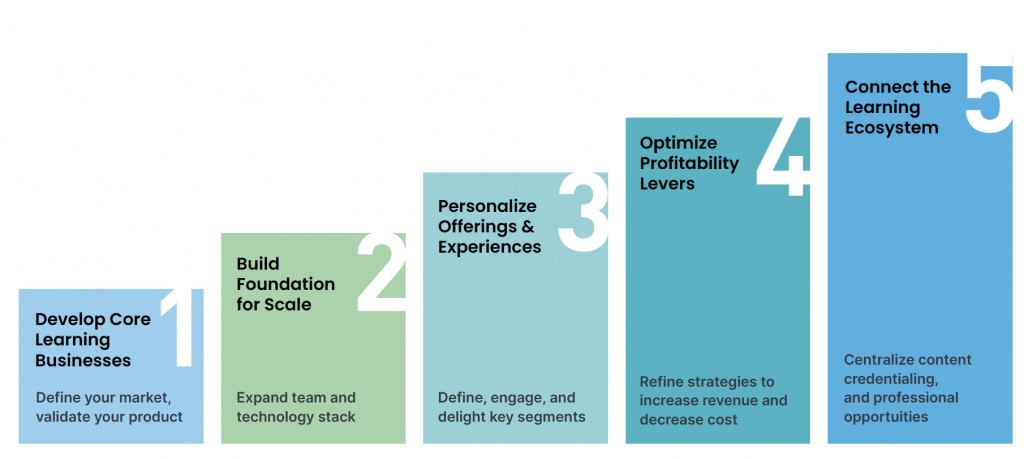What does it take to build a truly great professional training business? At Thought Industries, we think about that question all day, every day.
Leaders in the hundreds of businesses we work with often ask us:
- Are we on the right track?
- What should we do next?
- What strategies are we NOT considering?
- What best practices can we learn from?
- How do we stack up against our competitors? Against best-in-class?
This year, we launched a research initiative to find the answers.
We conducted in-depth interviews with over 30 learning businesses, management consulting firms, and media and internet companies to map their journey and understand their trajectory. We sought to understand: their key objectives and achievements, the pain points and obstacles that blocked them along the way, and what lessons they had learned and solutions they had developed.
Clear patterns emerged from these conversations – and we developed a maturity model to describe how we see great professional training businesses evolve and grow over time. Wherever your business lies on this model today, our hope is that this research will help you set ambitious future goals, and solve challenges that may get in the way.
Our Maturity Model for Professional Training

Moving from one to five, you unlock more growth potential – while it’s not necessary to work on each one in linear order, the pillars build on each other and increase in difficulty from left to right. Many organizations cycle through pillars multiple times, deepening their abilities within each one over time. In the end, as learning businesses improve in all pillars collectively, they raise the ceiling on what’s possible for their organization.
We use this framework to support learning businesses as they consider their growth strategy. We also partner with our customers to help them maximize impact every step of the way.
Let’s take a closer look at each pillar.
The 5 Pillars of Professional Training Maturity
Pillar 1: Develop core learning business
The first pillar is all about validating product-market fit. You identify a market or audience to serve, and develop a learning product that they’re willing to pay for. Your learning business may be your primary product, or a complement to other business lines (e.g., a consulting or equipment business). Your starting point may range from intensive, experiential training, to online, informational eLearning modules. You may serve consumers, businesses, or a mix of both. Your technological infrastructure may encompass an online learning platform you built or licensed, or may be limited to laptops, powerpoint slides, and whiteboard markers.
While your training business can have many starting configurations, you must start by validating that a viable market exists for your learning product.
Key Imperatives:
- Identify your ideal learner and their unmet learning need
- Build your core team
- Develop, sell, and refine your learning product
Pillar 2: Build foundation for scale
Once you’ve established product-market fit, you can build your capacity to grow in leaps and bounds. The second pillar is characterized by exploration on all fronts. Most often, you buy or build a modern customer learning platform that consolidates your tech stack and enables you to scale business operations and functionality. You then explore the range of capabilities of your system. This includes everything from expanding and polishing your course catalog to diversifying content modalities to tracking key metrics.
Naturally, the work of this pillar includes a lot of trial and error. It’s a dynamic time for learning businesses, as you lay technical, team, and content foundations that will enable the growth you hope to achieve over time.
Key Imperatives:
- Define the “must-have” capabilities to achieve scale
- Invest in strategic technologies and team competencies
- Prototype, test, and iterate scalable learning modalities
Pillar 3: Personalize offerings and experiences
After a period of exploration and expansion, most professional training businesses reach a plateau. At this point, adding more “one-size-fits-all” content can create confusion without having a net positive impact on growth and churn. To go further in your journey, you must differentiate your content and learning experience for your most important buyer personas.
Build learning paths for the different segments that make up your core audience, make content more searchable and navigable, and modularize your library. At the same time, optimize a more frictionless and seamless user experience, becoming more “sticky” for your customers.
All of these actions work together to draw in and delight your users to retain them over time. The work of this pillar brings greater clarity and sharpens the focus of your training business.
Key Imperatives:
- Develop learning journeys for your core learner personas
- Make content easily searchable, navigable, and (increasingly) modular
- Achieve sustained learner engagement
Pillar 4: Optimize profitability levers
The fourth pillar is optimizing the business model that undergirds everything. This takes many forms (e.g., partnerships, outsourcing, and services, to name a few), but at the heart of it is exploring adjustments to cost and revenue levers that will allow you to massively increase the profitability and growth of your learning enterprise.
Some of the levers you might adjust include:
- Brick-and-mortar vs. eLearning
- Instructor-led vs. self-paced
- One-size-fits-all vs. tailored
- Fee-based vs. subscription-based pricing
- Pay-per-user vs. pay-per-package
- Preset bundles vs. customized bundles
Keep in mind, every business model has its own unique challenges, and the goal in optimizing these “levers” is to keep a flexible outlook until you find the ideal balance to optimize profit and growth. There is no universal correct answer; a configuration that maximizes revenue for one learning business may lead to significant loss for another.
Key Imperatives:
- Iterate on business model to support rapid growth
- Refine pricing and packaging to increase profitability
- Monitor customer lifecycle KPIs (e.g., retention, expansion) to influence business strategy
Pillar 5: Connect the learning ecosystem
The best learning businesses realize that, while high-quality learning products are a necessary starting point, they aren’t enough on their own to realize the organization’s full growth potential. Your output is part of a larger learning ecosystem that consists of multiple sources of content and credentials, not to mention multiple skills and competencies your learners must develop in order to solve problems and advance in their organizations and careers. Accordingly, this final pillar is characterized by building strong connections between learners and the organization’s larger industry. Organizations in this stage build a community around impactful learning, high-profile certifications and credentials, and clear pathways for learners to achieve broader professional success.
A few ways cutting-edge learning businesses connect their ecosystems:
- Connect creators and learners (e.g., become hubs of curated external content)
- Enable learning in the flow of work (e.g., embedded content in frequently used apps)
- Reimagine credentials (e.g., consolidation of certifications from multiple platforms)
- Steer learners to opportunities (e.g., job placement, career pathing)
Mature learning businesses are confident in their own learning offerings while embracing the need to continually innovate. They do this flexibly yet boldly, redefining the learning landscape in the process.
Key Imperatives:
- Invest resources in highest-value solutions and services
- Divest and outsource low-value or commoditized offerings
- Experiment with advanced technologies
Intrigued? Schedule a demo to learn more
Which pillar best aligns with your professional training business, today?
What questions must be answered (or obstacles removed) before you can master the next pillar?
Our team is actively continuing this research, and in the meantime we’d love to share how our platform can support your training business journey. Schedule a demo to learn more about Thought Industries’ key features that will support your growth and success.



